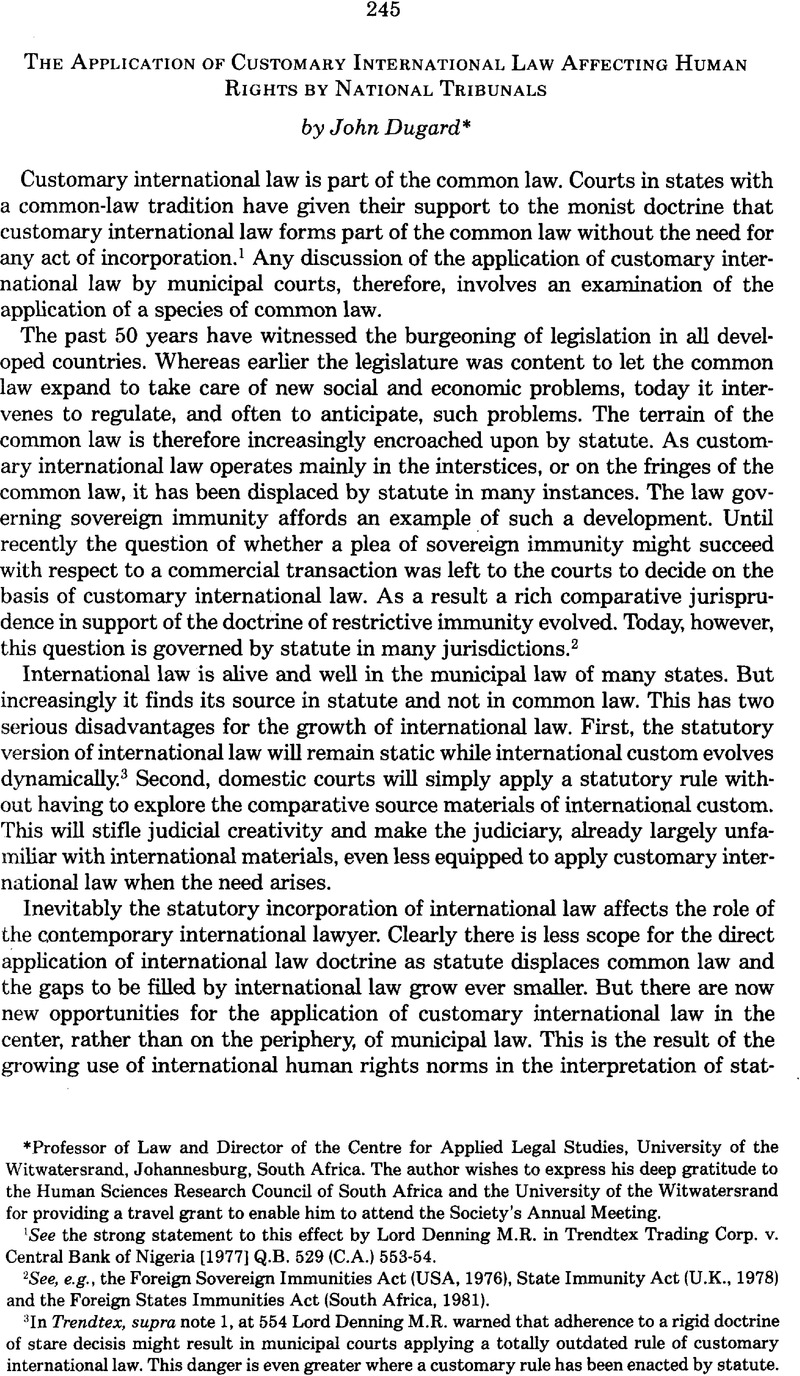Article contents
The Application of Customary International Law Affecting Human Rights by National Tribunals *
Published online by Cambridge University Press: 28 February 2017
Abstract

- Type
- Application of Customary International Law by National Tribunals
- Information
- Copyright
- Copyright © American Society of International Law 1982
References
1 See the strong statement to this effect by Lord Denning M.R. in Trendtex Trading Corp. v. Central Bank of Nigeria [1977] Q.B. 529 (C.A.) 553-54.
2 See, e.g., the Foreign Sovereign Immunities Act (USA, 1976), State Immunity Act (U.K., 1978) and the Foreign States Immunities Act (South Africa, 1981).
3 In Trendtex, supra note 1, at 554 Lord Denning M.R. warned that adherence to a rigid doctrine of stare decisis might result in municipal courts applying a totally outdated rule of customary international law. This danger is even greater where a customary rule has been enacted by statute.
4 Attorney General v. British Broadcasting Corp. [1980] 3 W.L.R. 109 (H.L.) at 130; Salomon v. Commissioner of Customs and Excise, [1967] Q.B. 116 at 143; H. HAHLO & E. KAHN, THE SOUTH AFRICAN LEGAL SYSTEM AND ITS BACKGROUND 114 (1968).
5 R. CROSS, STATUTORY INTERPRETATION 145 (1976).
6 H. WADE, ADMINISTRATIVE LAW 338ff (4th ed. 1977), B. SCHWARTZ & H. WADE, LEGAL CONTROL OF GOVERNMENT: ADMINISTRATIVE LAW IN BRITAIN AND THE UNITED STATES ch. 12 (1972).
7 For a survey of these decisions, see Duffy, English Law and the European Convention on Human Rights, 29 INT'L & COMP. L.Q. 584 (1980).
8 Sei Fuji v. State, 38 Cal.2d 718, 242 P.2d 617 (1952); Comacho v. Rogers 199 F. Supp. 155 (S.D.N.Y. 1961); Hatai v. INS, 343 F.2d 466 (2d Cir. 1965).
9 In Re Alien Children Educ. Litigation, 501 F. Supp. 544 (S.D. Tex. 1980). Doe v. Plyler, 628 F.2d 448 (5th Cir. 1980).
10 S. v. Adams; S. v. Werner 1981 (1) S.A.L.R. 187 (A.D.).
11 This right features prominently in every international human rights convention, including the Charter of the United Nations (Articles 55 and 56); it is the subject of a special convention, the International Convention on the Elimination of All Forms of Racial Discrimination, and has been translated into municipal law in many countries. Although the International Court of Justice carefully avoided pronouncing on this issue in 1966 in the Southwest Africa Cases ([1966] I.C.J. 6) it seems that Judge Tanaka's dissenting opinion, reaffirming the existence of a norm of nondiscrimination in international law, id. at 291-94, is today largely accepted.
12 Filartiga v. Pena-Irala, 630 F.2d 876 (2d Cir. 1980).
13 Fernandez v. Wilkinson, 505 F. Supp. 787 (D. Kan. 1980) at 795.
14 Waddington v. Miah, [1974] 1 W.L.R. 683 (H.L.); R.v. Deery, 20 EUROPEAN CONVENTION ON HUMAN RIGHTS Y.B. 827 (1977).
15 R.v. Secretary for the Home Department, ex parte Phansopkar; R.v. Secretary of State for the Home Department, ex parte Begum [1976] Q.B. 606 at 626.
16 See Duffy, supra note 7, at 599-605.
17 Supra note 12.
18 28 U.S.C. 1350 (1976). The Alien Tort Claims Act was passed in 1789.
19 505 F.Supp. 787, 795.
20 654 F.2d 1382, 1388, 1390 (10th Cir. 1981).
21 507 F.Supp. 1177 (D. Conn. 1980).
22 290 Or. 611, 625 P.2d 123 (1981).
23 In Lareau v. Manson the court described the instruments in question as “evidence of the evolving standards of decency” basic to the Eighth Amendment jurisprudence; at note 18 of the judgment.
24 In Sterling v. Cupp the court categorized the instruments “as contemporary expressions of the same concern with minimizing needlessly harsh, degrading or dehumanizing treatment of prisoners that is expressed in Article 1(13) of the Oregon Constitution.” At page 131 and note 21.
25 1978 (1) S.A.L.R. 893 (A.D.).
26 1980 (2) S.A.L.R. 894 (0). Noted by Dugard, Jurisdiction Over Persons on Board an Aircraft Landing in Distress, 30 INT'L & COMP L.Q. 902 (1981).
27 Winter v. Minister of Defence, 1940 A.D. 194, 198. See also S.v. Tuhadeleni, 1969 (1) S.A.L.R. 153 (A.D.), 173-74, 176.
28 S.v. Adams; S v. Werner 1981 (1) S.A.L.R. 187 (A.D.)
29 [1976] Q.B. 198 (C.A.).
30 Id. at 207.
31 R. v. Chief Immigration Officer, Heathrow Airport, ex parte Salamat Bibi [1976] 3 All E.R. 843 (C.A.) at 847-48. See also R.v. Secretary of State for the Home Department, ex parte Hosenball, [1977] 3 All E.R. 452 (C.A.) 457.
32 Decisions of British Courts During 1976-1977, 48 BRIT. Y. B. INT'L L. 351 (1976-1977).
33 Supra, note 7, at 597-98.
34 [1980] 3 W.L.R. 109 (H.L.).
35 At 128. See also the speech by Lord Scarman at 130.
36 [1979] 2 All E.R. 620 (Ch).
37 Id. at 648.
38 Article 17.
39 Article 12.
40 1966 I.C.J. 6.
41 Id. at 48.
42 See J. DUGARD, THE SOUTHWEST AFRICA/NAMIBIA DISPUTE 357 (1973).
- 1
- Cited by


